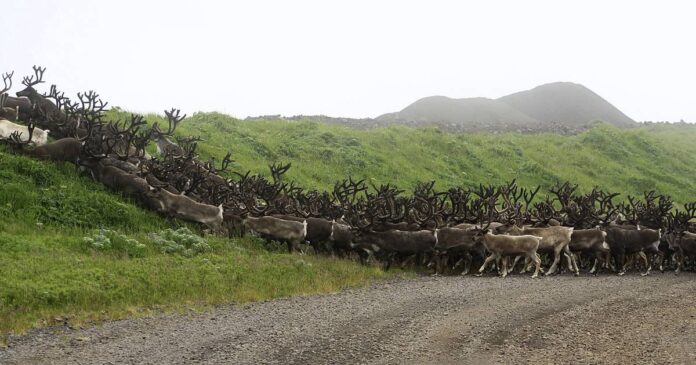Last week I manned a booth at a convention trade show in Sitka.
The Alaska Travel Industry Association’s end-of-season meetup offers insiders a sneak peek at some of the new travel options around the state.
There’s one event called the “Shark Tank,” based on the popular TV show. Here, travel and tourism business leaders consider new ideas from Alaska entrepreneurs.
Ryne Olson of Chena Outdoor Collective in Fairbanks wants to develop what she calls “reindeer tourism.”
“Reindeer have a unique history in Alaska,” said Olson.
Olson is better-known as a musher who has fielded teams in the Iditarod and the Yukon Quest.
“We’re already offering short walks with the reindeer for $65 per person,” she said.
But Olson wants to offer more options, including sleigh rides with reindeer, backpacking trips and a “destination” setting for larger groups.
Her goal is to make the Chena Outdoor Collective a hub for reindeer tourism.
Haley Johnston has guided wilderness trips for more than 10 years. Now, though, she has her own company called Tundra Travels.
Johnston specializes in backpacking trips in some of Alaska’s more remote areas: the Arctic National Wildlife Refuge and Gates of the Arctic National Park.
I asked her if she took groups down the scenic rivers in ANWR and Gates of the Arctic. “Oh yes,” she said. “I’ve led those trips. But we’re hikers, not floaters,” she said with a smile.
As she built out her trips, she added components that were important for her. She wanted her guides to be year-round Alaska residents. Also, she wanted to develop a model to donate a substantial sum to nonprofit organizations committed to conservation.
Johnston came to the Shark Tank to help fund more equipment for more guides to offer more trips.
Down in Juneau, Peter Nave has followed the story at Eaglecrest Ski Area. Eaglecrest recently purchased a gondola to take visitors up the mountain year-round.
Nave thought Eaglecrest would be a good site for a “via ferrata,” which he calls a “combination between hiking and rock climbing.”
More specifically, a via ferrata is a course over steep, exposed mountain routes using fixed cable, chains and ladders. Literally translated as “iron way,” climbers put on a harness and make their way through the course.
“Our proposed course is about a half-mile and it would be very family-friendly,” said Nave.
Nave still is working out some details with Eaglecrest, but looks forward to offering an “experience steeped in mountain culture.”
Capt. Jack Finnegan has offered fishing trips in Ketchikan for many years. But Finnegan also has years of experience working with adults experiencing a variety of disabilities.
These two skillsets finally mashed up in Finnegan’s head when it became obvious that his fishing boats were not wheelchair-accessible. The idea for “Fishability Alaska” was born.
Finnegan’s quest is to construct a custom boat with accessibility as a core design component. Travelers using wheelchairs are just one set of visitors. “Not all disabilities are visible,” said Flannigan. “Sometimes visitors with disabilities includes hearing or vision impediments, or PTSD,” he said. “Many travelers are on the autism spectrum.”
Flannigan has some good stories about helping blind visitors catch fish. But with the bow lander on his boat-of-dreams, he could run up on the beach so folks could go beachcombing, tide-pooling or explore wilderness trails on a far-off island.
The audience in attendance at the tourism Shark Tank was listening carefully. Many of the ideas presented offered completely new categories for travelers, such as the via ferrata and reindeer backpacking trips.
This made it difficult for the judges to choose winners, who received between $8,000 and $10,000 toward their idea.
“These entrepreneurs are really putting their hearts out there,” said Dale Wade, director of marketing at the Alaska Railroad. “There’s an application process, then pre-session vetting and finally the presentation at the show. I really admire them.”
Winners of the Shark Tank competition include Ryne Olson and her hiking reindeer, as well as Haley Johnston and her Arctic backpacking company. Judges based their decision in part on how much of a difference the Shark Tank funding would make in the overall success.
Most of the Shark Tank participants were involved in a variety of other fundraising, including personal savings, funds from friends and relatives and other crowd-funding sources.
The Shark Tank contestants did not have a monopoly on new activities and adventures in Alaska. There are many new adventures, including new cruises to new ports, a new emphasis on cultural tourism featuring Native Alaskans and new attention on Alaska’s unique culinary offerings, including microbreweries.
The Alaska Travel Industry Association hosts travelalaska.com, which produces an annual travel planner. It’s a new catalog of year-round tours and adventures. Most of the planners are sent Outside to prospective visitors. But you can order one for yourself and start planning a visit to some new parts of Alaska.










